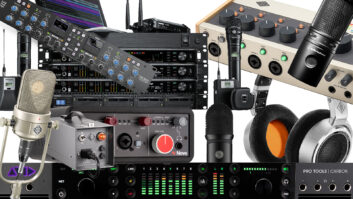Los Angeles, CA – WNAMM Booth # 7111, Arena… Would you gamble on a trip to Dublin, Ireland to propose on February 29th, leap day, to that special someone if, by Irish legend, that person is required to accept? That’s the premise of the January 2010 release of Leap Year, a new film from Universal Pictures and Spyglass Entertainment. Directed by Anand Tucker and starring Amy Adams, Matthew Goode, Adam Scott, and John Lithgow, the romantic comedy is expected to be one of the major film releases to kick off the New Year. The film’s soundtrack was composed by Randy Edelman, winner of 10 BMI Film Music Awards and was mixed and engineered by music scoring mixer Elton Ahi. Together, they’ve created a magical soundtrack and they did it using Q10 reference monitors from Equator Audio Research.
Ahi, a well-known figure in Hollywood’s film sound community, has recorded and mixed over 100 major film projects, including the summer 2009 blockbuster Mummy: Tomb of the Dragon Emperor from Universal Pictures, Fox 2000 Pictures’ comedy 27 Dresses, along with the classic film Last of the Mohicans, which won an Oscar for sound. With credits like these, Ahi clearly knows a bit about film sound. That’s precisely why he depends on his Equator Q10’s and the Secondary Reflection Correction™ (SRC) software, which is part of Equator Audio’s optional Q Series Room Analysis Calibration Kit.
The Leap Year score was recorded and mixed by Ahi at Air Studios in London and Rusk Sound Studios in Hollywood. Using five Q10 studio reference monitors as part of a 5.1 surround sound setup, Ahi uses his Equator monitors wherever he works. “I’ve really come to depend on my Q10’s,� said Ahi. “Combined with the SRC software, this is an unbeatable monitoring setup.�
“When you’re recording and mixing an orchestra, it’s very challenging to capture all the nuances a large ensemble of musicians creates,� he continued. “The monitors must reproduce the sound accurately and that’s where the Q10’s excel. The sound quality is transparent and remarkably consistent regardless of whether the music passage is loud or soft. Further, the monitors’ imaging capabilities are equally accurate, enabling you to hear the placement of the sounds. The Q10’s are very true to the source. It’s this level of detail that makes all the difference with a film score. If the music doesn’t convey the emotions of the scene, everything suffers. For this type of work, the Q10’s are terrific.�
As any film sound engineer will confirm, the accuracy of the control room’s sound characteristics is critical. Without this, a mix can sound radically different from one location to another. To ensure consistency among mixing rooms, Ahi finds Equator Audio’s SRC software to be a major benefit.
“While most of the rooms where I work are very carefully acoustically engineered,� Ahi explained, “that doesn’t make them perfect. There are always reflections from the console surface, video monitors, and other hard surfaces that can compromise the mix position. This is why the SRC software is so valuable; it enables you to tune the room so that you have a consistent sounding environment in which to work. While the Q10’s, themselves, are very accurate, the SRC software goes one step further to ensure accuracy in the mix and the results I’ve obtained have been very impressive. This software levels the playing field between room discrepancies so that what you hear remains consistent from one studio to another.�
As he headed back into the control room, Ahi offered this closing thought about Equator Audio’s Q10 monitors and the SRC software. “The Q10’s deliver a very natural, accurate sound that never gets harsh or fatiguing, which makes working much more comfortable during those long sessions, and the SRC software enables me to set the monitors for the characteristics of my room and feel confident about what I’m hearing. Together, they provide a great mixing experience. What I hear in the control room ends up on screen or other medium without any surprises.�
About the Equator Audio Research Q10 monitors and SRC Room Analysis Software
The Q10 monitors are a digitally controlled 2-way active 10-inch woofer/compression driver horn system employing Equator Audio’s Zero-Point Reference coaxial design. They deliver 400 watts of peak power and 112dB of SPL. Each monitor has an internal CPU which handles a host of tasks including matching the transducers, incorporating the system’s no-slope crossover, and enabling networking and room compensation. Equator Audio’s SRC software identifies and corrects for room conditions as well as secondary reflections created by sound waves bouncing off mixing consoles and other reflective surfaces that, when combined with the original direct sound energy, results in comb-filtering due to phase cancellation. This software directs the Q Series’ digitally-controlled transducers to optimize the listening position—bringing a level of consistency to the mix/monitor process.
About Equator Audio Research
Equator Audio Research is committed to delivering studio reference monitor solutions that overcome the myriad of challenges faced in today’s production environment. Audible obstacles such as comb-filtering from computer screens and consoles, standing waves, uneven first reflections, asymmetrical speaker placement, and poor low frequency diffusion can easily degrade the listening experience. Equator Audio Research designs products that overcome these challenges. Our products are used daily in mission-critical applications at many of the world’s finest recording studios. For additional information on all Equator Audio products, visit the company online at www.equatoraudio.com.
###
Photo info: Image of Elton Ahi with his Equator Q10 monitor.







